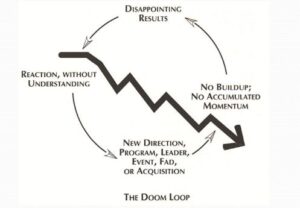You probably have aspirations, and you know that to accomplish them you need to apply yourself and get going on relevant work. But you may also be looking, even if subconsciously, for a Hollywood-style breakthrough. A Eureka moment.
And that’s holding you back.
Researcher and Harvard Business School Professor Teresa Amabile and her colleagues, including researcher Steven Kramer, spent nearly 15 years studying the psychological experiences and performance of people doing complex and creative work in organizations. They looked into workers’ emotions, moods, motivation levels, and perceptions of their work environment. The researchers studied what work they did and what events stood out for them. Their aim was to find what contributed most to the highest levels of creative output. (1)
Enter the “progress principle.”
Leveraging the Progress Principle
Question:
What sets your best days—your most productive, engaging, and fun ones—apart from your worst days?
When the researchers compared the best days of the workers with their worst days (specifically, their motivation levels, overall mood, and specific emotions), they found that progress in the work was the most common event triggering the best days. And relatedly, setbacks in the work were the most common event summoning the worst days.
Importantly, even minor progress on things could result in outsized positive effects. They found a clear “inner work life effect” related to progress and small wins.
The researchers could see workers enter a “progress loop,” with consistent progress on meaningful work creating a positive inner work life, which in turn drives performance.
“Of all the things that can boost emotions, motivation, and perceptions during a workday, the single most important is making progress in meaningful work. And the more frequently people experience that sense of progress, the more likely they are to be creatively productive in the long run. Whether they are trying to solve a major scientific mystery or simply produce a high-quality product or service, everyday progress—even a small win—can make all the difference in how they feel and perform.”
-Teresa M. Amabile and Steven J. Kramer, “The Power of Small Wins”
The Progress Principle in Action
Working on a big, important project with a tight deadline? If you’re in a company, maybe it’s a product launch, marketing campaign, or a system upgrade. In a nonprofit, maybe it’s a fundraising campaign, big event, or recruitment drive. Or in a school district, maybe it’s a curriculum overhaul, technology integration, or implementation of safety protocols. In a government agency, maybe it’s a public health initiative or disaster recovery program. Maybe you’re working on a career change or writing a book.
Tip: Stop stressing over the deadline and focusing only on the final outcome. Instead, break the project into smaller tasks (e.g., researching, outlining, drafting, editing, presenting, improving, releasing, promoting). And when you complete a task, celebrate your progress.
Share updates with your colleagues. Feel the sense of achievement and watch how it motivates you to keep going while also helping you navigate setbacks.
Implication for Managers: The Power of Progress in Action
How does this work for managers? Amabile and her associates found that facilitating progress, even including small wins, is the best way to motivate people on a daily basis
“The key to motivating performance is supporting progress in meaningful work.”
-Teresa M. Amabile and Steven J. Kramer, “The Power of Small Wins”
Unfortunately, the managers they surveyed didn’t view that as high on their list of motivational tools. On the contrary: it was at the bottom of their list.
So, what can you do as a manager to boost motivation and create the conditions for productive, creative output by your team?
First, you can use what the researchers called “catalysts” and “nourishers.”
- Catalysts are actions you take to support the work of your team. For example: setting clear goals, giving workers autonomy, providing adequate resources and time, helping, fostering the free exchange of ideas, facilitating learning from challenges and successes, and tracking and celebrating progress.
- Nourishers are acts of support. For example: providing encouragement, emotional comfort, recognition, and respect. Helping people feel a sense of affiliation and belonging.
On the flipside, you can minimize what the researchers called “inhibitors” and “toxins.”
- Inhibitors can range from not providing support (or enough of it) to your team to actually interfering with their work. As management guru Peter Drucker once wrote, “Most of what we call management consists of making it hard for people to get their work done.”
- Toxins are things like discouragement, disregard for people’s emotions, and disrespect.
These inhibitors and toxins lead to negative feedback loops—the reverse of the progress loop. They destroy motivation and productivity.
Of course, even good managers can sometimes fall short with their behavior, not least because they’re overwhelmed and under pressure.
Managing Setbacks
You’re bound to experience challenges in your work sometimes. As a manager, it’s essential that you manage setbacks in your team proactively.
Amabile and her colleagues found that “Small losses or setbacks can have an extremely negative effect on inner work life.” Indeed, negative events can have a more powerful impact than positive events. So, managers are wise to address frictions, hassles, and setbacks directly and quickly—and to view this as an essential part of their job.
“If you want to foster great inner work life, focus first on eliminating the obstacles that cause setbacks. Why? Because one setback has more power to sway inner work life than one progress incident.” -Teresa Amabile, The Progress Principle
In business schools and management books, the focus is on managing people and organizations. Seems like it makes sense, but this research points to an important reframe:
When you focus on managing progress, you’re better able to manage people—and even teams and organizations.
“…the most important implication of the progress principle is this: By supporting people and their daily progress in meaningful work, managers improve not only the inner work lives of their employees but also the organization’s long-term performance, which enhances inner work life even more…. Knowing what serves to catalyze and nourish progress—and what does the opposite—turns out to be the key to effectively managing people and their work.”
-Teresa M. Amabile and Steven J. Kramer, “The Power of Small Wins”
The Power of Momentum
This research resonates with the concept of momentum in physics, which is “mass in motion” (the product of the mass of something and its velocity). Think of a big 18-wheeler barreling down the highway. Massive momentum.
Some key points about momentum:
Gaining momentum through consistent, purposeful action fuels motivation, while procrastination slows momentum and saps motivation.
Ask yourself this:
What can you do now to build momentum toward something that matters?
If you have goals you want to achieve and a clear vision of a successful future you’re moving toward, are you taking enough action now and every day to create and build momentum toward your desired ends?
The Flywheel Effect
Author Jim Collins famously described this as a “flywheel” in his book, Good to Great.
He described a massive metal disk, weighing thousands of pounds, mounted on an axle. Naturally, it takes great effort to get it to move at first. But if you keep pushing consistently, it begins to move, ever so slowly. Then a bit faster. At some point, after disciplined work and sweat equity over time, there’s a breakthrough:
“The momentum of the thing kicks in your favor, hurling the flywheel forward, turn after turn… whoosh!… its own heavy weight working for you. You’re pushing no harder than during the first rotation, but the flywheel goes faster and faster. Each turn of the flywheel builds upon work done earlier, compounding your investment of effort.”
Eventually, you generate an “almost unstoppable momentum.” The flywheel effect.
“Each turn builds upon previous work as you make a series of good decisions, supremely well executed, that compound one upon another. This is how you build greatness.” -Jim Collins, Turning the Flywheel: A Monograph to Accompany Good to Great

Collins notes that the good-to-great transformations in their massive research set didn’t happen in one fell swoop with a single grand program, defining action, or miracle moment. Instead, it took a quiet, deliberate, and cumulative process. Turning the flywheel.
Collins describes it as an organic evolutionary process, a pattern of buildup via an accumulation of consistent steps. The pattern: “disciplined people, disciplined thought, disciplined action.” He cites executives in their own words from the companies they studied:
- “a series of incremental changes”
- “an evolution”
- “very deliberate”
- “evolutionary… building success upon success”
For this kind of business success, effort and action alone aren’t enough. According to Collins, it also requires “an underlying, compelling logic of momentum.” One might say it’s a powerful combination of a powerful business model with an effective strategy that’s well executed consistently over time. When it works right, he says that doing A almost inevitably leads to B, which inexorably leads to C and then D in a reinforcing loop. Round and round the flywheel.
For it to work, you must discover what your flywheel is in your current context (e.g., market and industry conditions). You don’t have to be a pioneer, first mover, or even unique to make it work. But you do need a clear and deep understanding of your flywheel, along with supreme execution of it over a lengthy period of time.
The flipside of the flywheel effect is what he calls the “doom loop.” It’s when organizations start with one thing, then stop and change course. They lurch back and forth impatiently, perhaps even desperately, seeking the big breakthrough that never comes. It leads only to decline and frustration.

The Power of Compounding
These principles and practices of progress, momentum, and flywheels have echoes in the financial world, with the phenomenon of compounding and compound interest: Savvy savers earn interest both on the money they save and on the interest they earn. Over time, such compounding can lead to spectacular results—huge rewards for wise, patient, and disciplined savers.
Benjamin Franklin noted this centuries ago:
“Money makes money. And the money that money makes, makes money.”
The phenomenon is so powerful that it’s been called “the eighth wonder of the world,” a quotation often attributed to Albert Einstein.
“Enjoy the magic of compounding returns. Even modest investments made in one’s early 20s are likely to grow to staggering amounts over the course of an investment lifetime.” -John C. Bogle, investor and philanthropist

Conclusion
There are many benefits that come from using the progress principle and its related practices. The advantages include greater motivation, effectiveness, satisfaction, resilience, and confidence. And big results.
It’s also an antidote to the common traps of overthinking, worrying, and rumination—as well as indecision and inertia.
Unlocking the power of progress and small wins can lead to big changes. Why not get started with it, today?
Wishing you well with it.
-Gregg

Reflection & Action Questions
- Are you leveraging the progress principle in your life and work?
- Are you managing your setbacks proactively?
- Have you discovered the flywheel that will generate powerful momentum for you?
- What more will you do on these fronts, starting today?
Tools for You
- Traps Test (Common Traps of Living) to help you identify what’s getting in the way of your happiness and quality of life
- Quality of Life Assessment so you can discover your strongest areas and the areas that need work, then act accordingly.
- Leadership Derailers Assessment to help you identify what’s inhibiting your leadership effectiveness
Related Articles & Resources
- “How Inertia Keeps Us from Making Needed Changes”
- “What Keeps Us from Moving On?”
- “The Incredible Benefits of Being Action-Oriented”
- “Designing Your Work for Flow”
- “How to Break Bad Habits and Create Good Ones”
- “Goal-Setting Best Practices: Beyond SMART Goals”
- Teresa M. Amabile and Steven J. Kramer, “The Power of Small Wins,” Harvard Business Review, May 2011
- Teresa Amabile, The Progress Principle: Using Small Wins to Ignite Joy, Engagement, and Creativity at Work
Postscript: Inspirations on Progress and Small Wins
- “Success is the sum of small efforts, repeated day in and day out.” -Robert J. Collier, publisher
- “You have to put in many, many, many tiny efforts that nobody sees or appreciates before you achieve anything worthwhile.” -Brian Tracy, author and speaker
- “Tiny victories are like gems scattered on your journey, notice them.” -Emma Xu
- “The great victory, which appears so simple today, was the result of a series of small victories that went unnoticed.” -Paulo Coelho, Brazilian novelist
-
“’the progress principle’: Pleasure comes more from making progress toward goals than from achieving them.” -Jonathan Haidt, The Happiness Hypothesis
- “Small wins fuel transformative changes by leveraging tiny advantages into patterns that convince people that bigger achievements are within reach.” -Charles Duhigg, author
- “Track your small wins to motivate big accomplishments.” -Teresa Amabile, researcher
- “The most effective form of motivation is progress. When we get a signal that we are moving forward, we become more motivated to continue down that path. In this way, habit tracking can have an addictive effect on motivation. Each small win feeds your desire.” -James Clear, author
(1) Their research methodology included end-of-day email surveys sent to 26 project teams from seven companies, comprising 12,000 diary entries from 238 people. (Source: Teresa M. Amabile and Steven J. Kramer, “The Power of Small Wins,” Harvard Business Review, May 2011.) The idea behind the progress principle and small wins has resonance with other ideas and frameworks, including agile software development (which often includes breaking product development work into small increments, including sprints and rapid iterations) and innovation approaches like lean startup methodology, including its focus on “minimum viable products.” Entrepreneur and author Peter Sims advocates making “little bets.”
+++++++++++++++++
Gregg Vanourek is a writer, teacher, and TEDx speaker on personal development and leadership. He is co-author of three books, including LIFE Entrepreneurs: Ordinary People Creating Extraordinary Lives (a manifesto for living with purpose and passion) and Triple Crown Leadership: Building Excellent, Ethical, and Enduring Organizations (a winner of the International Book Awards). Check out his Crafting Your Life & Work online course or get his monthly newsletter. If you found value in this article, please forward it to a friend. Every little bit helps!


























